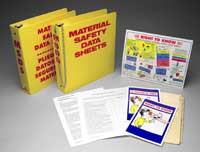 |
 |
| MSDS Topics |
Free Sites | FAQ's | Regulations | Glossary | Software | Suppliers |
| Books | Forum | Poll | Fun stuff | Quiz | Store | |
| MSDS and safety supplies | Search ALL our MSDS info | |||||
 | |||
 |
 |
 |
|
| Title: 02/07/1990 - The transmittal of material safety data sheets (MSDS). | |
| Record Type: Interpretation | Standard Number: 1910.1200 |
February 7, 1990
The Honorable John C. Danforth
United States Senator
943 U.S. Courthouse
811 Grand Avenue
Kansas City, Missouri 64106
Dear Senator Danforth:
|
This is in response to your letter of January 26 to the Occupational Safety and Health Administration (OSHA), on behalf of your constituent, Mr. Ernest Isenberg, President of the Western Extralite Company in Kansas City, Missouri. Mr. Isenberg wrote to you concerning the transmittal of material safety data sheets (MSDS) as required under OSHA's Hazard Communication Standard (HCS), 29 CFR 1910.1200. Mr. Isenberg specifically was concerned about the requirement for distributors to provide MSDS to downstream users of hazardous chemicals. The HCS requires MSDS to be provided by the chemical manufacturer and downstream distributor only at the time of initial shipment or when the MSDS is updated or changed to contain new or significant information about the chemical's hazards. Mr. Isenberg would like OSHA to require that an MSDS be included with every package of chemical product and/or for OSHA to require "labeling the product to include MSDS information." Mr. Isenberg feels such a requirement would "provide greater safety as the precautions needed to be observed in usage and in case of accident are available at the point of use, and each time it is used." |  These handy MSDS binder training inserts and other OSHA compliance materials are available at Safety Emporium. |
Under the HCS, employees must have ready access to the MSDS information. In the construction example Mr. Isenberg utilizes in his letter, it is the construction worker's employer's responsibility to maintain current copies of MSDS in a central location on the worksite in any manner that ensures that employees are able to refer to them while they are in their work areas during all workshifts. This may be accomplished in any manner, by keeping a hard copy of the actual data sheets themselves, or by the use of computer terminals, a microfiche machine or telefax. The key to compliance with this provision is that employees have no barrier to access the information and that the MSDS be available during all workshifts.
In summary, an effective hazard communication program involves more than just the provision of MSDS to employees. An effective hazard communication program is one in which all elements of the standard are addressed, including the maintenance and accessibility of MSDS, the labeling of hazardous chemicals in the workplace and the provision of employee information and training. I hope this discussion will be useful to Mr. Isenberg in understanding the Agency's intent behind the promulgation and enforcement of the MSDS and other provisions of the Hazard Communication Standard. Please feel free to contact us again if we can be of further assistance. Sincerely, Gerard F. Scannell Entry last updated: Saturday, June 11, 2016. This hypermarked and content-enhanced page is copyright 2001-2025 by ILPI, all rights reserved. Unauthorized duplication or posting on other web sites is expressly prohibited. For questions, comments and concerns, please contact us at our MSDS email address. The official, public domain, OSHA version of this document is available at http://www.osha.gov/pls/oshaweb/owadisp.show_document?p_table=INTERPRETATIONS&p_id=19924&p_text_version=FALSE |